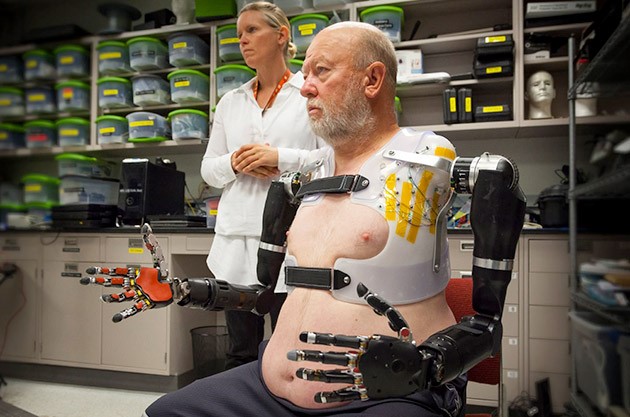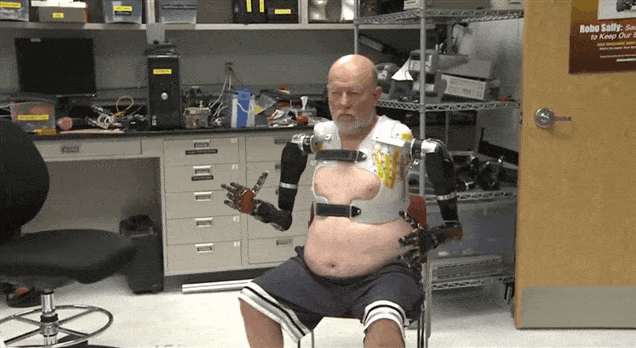
Following an electrical accident that ravaged both of his arms, Les Baugh of Colorado has been a double shoulder-level amputee for 40 years. But now, as an older man, Baugh is the first person to wear and simultaneously operate two robotic prosthetic limbs with his mind. The prostheses in question, called the Modular Prosthetic Limbs, were developed over the course of a decade by John Hopkins University Applied Physics Laboratory (APL) to perform a variety of tasks by thinking and channeling neural signals through a neural/electrical interface.
Baugh can be seen testing the devices in the video below; note how his artificial limbs are moving in full 3 degrees of freedom, shoulder, elbow, and hand, allowing him to pick-up the cup placed on the shelf. Controlling the prostheses is not as simple as it may appear; Baugh must first position the shoulder, then the elbow, and finally the hand.
But in order to arrive at this stage, Baugh needed to undergo a surgery called targeted muscle reinnervation, by which the nerves in a specific muscle are cut and/or de-activated, then reattached to residual nerves of the amputated limb. “It’s a relatively new surgical procedure that reassigns nerves that once controlled the arm and the hand,” explained Johns Hopkins Trauma Surgeon Albert Chi, M.D. “By reassigning existing nerves, we can make it possible for people who have had upper-arm amputations to control their prosthetic devices by merely thinking about the action they want to perform.” Once Baugh recovered, he began the arduous training of learning how to use the modular prosthetic system, first beginning with the pattern recognition system before moving on the mind-to-prostheses portion.

The pattern recognition system is used to identify individual muscles that are contracting, how well are they communicating, and their amplitude and frequency; this information is then translated into movements within the prosthetic, explained Dr. Chi. After this step in the learning was completed, Baugh was fitted for a custom socket for his torso and shoulder to support the prostheses and make the neurological connections with the reinnervated nerves.
While the socket was being constructed, Baugh trained on a Virtual-Reality Environment (VIE) that mimics the actual brain-computer interface of prosthetic limb system to the point being interchangeable with the actual prosthetic limb. And finally, by the time the hardware was ready, so was Baugh. Upon activating the device, he immediately remarked, “I just went into a whole different world.” He then proceeded lift objects, all while only having had 10 days’ worth of training. “This was significant because this is not possible with currently available prostheses. He was able to do this with only 10 days of training, which demonstrates the intuitive nature of the control,” stated APL’s Courtney Moran, a prosthetist working with Baugh.
In addition to Baugh’s unprecedented rate of adoption, he was also able to control a combination of motors across both arms simultaneously, something of a first for bimanual control schemes. The next step of the research is to provide Baugh with a pair of limb system that he can use at home.
Source: Jhuapl.edu
Advertisement
Learn more about Electronic Products Magazine





